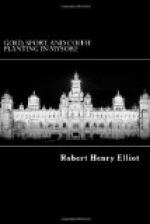FOOTNOTES:
[54] I am now so satisfied with the capacity of these soils to keep themselves cool, that I am applying them as a top dressing to land deficient in shade and dry ridges. Since writing the above, I have ascertained from my manager the interesting fact that about seven weeks after putting down the red earth, newly grown white roots were found to be running all through this earth, though no rain had fallen from the time of the application of the soil up to the time the growth of the rootlets was observed. The adjacent land, to which virgin forest top soil had been applied, had no such growth of new rootlets, nor had any of the adjacent land, to which no top dressings had been applied. The red earth had evidently the power of taking in sufficient moisture from the atmosphere to stimulate a growth of young roots. The red earth was applied on February 20th, and no rain fell till April 7th. This growth of new rootlets, I may add, was also observed in another part of the plantation to which, a top dressing of the red earth had been applied.
[55] The full analyses of these leaves and twigs are given in the Appendix to Dr. Voelcker’s work, “The Improvement of Indian Agriculture,” which contains other analyses of interest to the planter. This important work should, I may repeat, be in the hands of all those interested in tropical cultivations.
CHAPTER XIII.
NURSERIES.
Since the introduction of the Coorg plant, it has been customary for Mysore planters to send annually to Coorg for seed, and they have always endeavoured to obtain it from the best coffee grown on the best land, and, as the results from this practice have been very satisfactory, it may seem that no better course could be suggested. But till all courses are tried it is certainly open to doubt whether this is the best, and I am now experimenting with seeds produced not from the richest, but from the poorest and most exposed portion of a Coorg estate (but of course neither so poor nor exposed as to be incapable of producing strong, healthy trees and sound seed), and I think it probable that seed from such trees will produce hardier plants than can be produced from seed gathered in rich and sheltered situations. As regards the climate from which the seed should be produced, one well-known planter, Mr. Edwin Hunt, writing in the “Madras Mail,” Feb. 27th, 1891, says that he attaches the greatest importance to change of seed irrespective of the poorness or richness of the soil on which it has been raised, and thinks change of climate does as much as change of soil, and has for some years found it advantageous to procure seed from the wettest climate for the driest climate, and vice versa. I have had no experience on this point as regards coffee, but it may be interesting and useful from a shade-planting point of view, to




